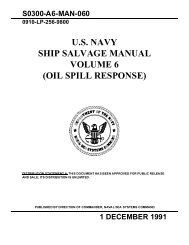June 2011 - Supervisor of Salvage and Diving
June 2011 - Supervisor of Salvage and Diving
June 2011 - Supervisor of Salvage and Diving
Create successful ePaper yourself
Turn your PDF publications into a flip-book with our unique Google optimized e-Paper software.
By: Stephanie Brown<br />
AVAILABLE RESOURCES:<br />
• Information on thous<strong>and</strong>s <strong>of</strong> hazardous chemicals, health hazards, recommended protective clothing, <strong>and</strong><br />
chemical properties. Also, see what additional hazards might occur if chemicals you select are mixed together.<br />
http://cameochemicals.noaa.gov/<br />
• NOAA <strong>of</strong>fers helpful Contaminated Water <strong>Diving</strong> reports at http://www.ndc.noaa.gov/rp_cwd.html<br />
• OSHA’s Hazardous Waste Operations <strong>and</strong> Emergency Response regulations (29 CFR 1910.120) at http://www.osha.gov<br />
under Regulations > 29 CFR<br />
• Also check out SUPSALV’s “Guidance for <strong>Diving</strong> in Contaminated Waters” <strong>and</strong> other resources at http://www.supsalv.org<br />
under 00C3 > Contaminated Water <strong>Diving</strong>.<br />
• NAVSEA 00C <strong>Diving</strong> Division has a limited supply <strong>of</strong> containment pools, an inflatable shower tent <strong>and</strong> a sprayer unit<br />
meant for equipping a decontamination station in the event that no other resources are available to a dive team.<br />
The most important decontamination solution is potable water. A plentiful supply <strong>of</strong> potable water, preferably from a low<br />
pressure hose hooked up to a municipal water supply, large water tank or ship’s stores, is the first <strong>and</strong> last step <strong>of</strong> all decontamination<br />
procedures. If a hose to a supply is not available, smaller containers (e.g., 5-gallon buckets, collapsible plastic<br />
containers, Hudson sprayers) <strong>of</strong> potable water could be used. The water<br />
should not be under pressure any higher than typical municipal water<br />
pressure <strong>of</strong> 40-70 psi. High pressure hoses, like pressure washers, may<br />
damage the diver’s suit, force contaminants into seams or contaminate<br />
nearby surface support personnel. In some instances a thorough rinse<br />
with potable water is all the decontamination the diver needs.<br />
Figure 1: It is important to incorporate a non-skid<br />
mat in the bottom <strong>of</strong> containment pools used in a<br />
decon station to reduce slip hazards<br />
A strong solution <strong>of</strong> antimicrobial soap (dish soap typically has more<br />
surfactant than h<strong>and</strong> soap) is the next most commonly used decontamination<br />
solution. Soap’s surfactant action will remove most organic<br />
contamination, <strong>and</strong> scrubbing with soap water will remove sedimentassociated<br />
inorganics (i.e. metals). Soap will also wash away biological<br />
contaminants.<br />
- U.S. EPA ENVIRONMENTAL RESPONSE TEAM DIVER<br />
DECONTAMINATION SOLUTIONS<br />
<strong>June</strong> <strong>2011</strong> 19

















